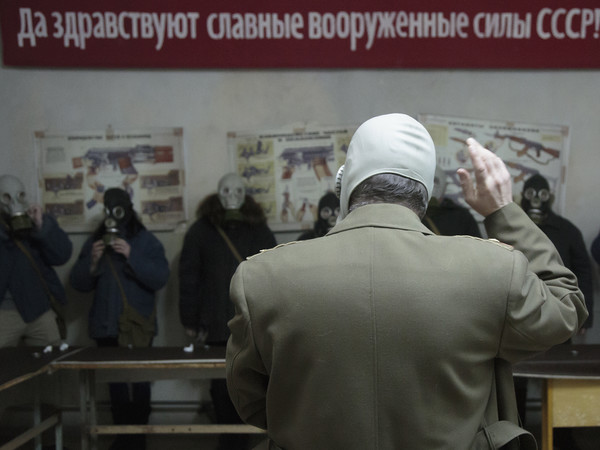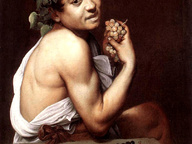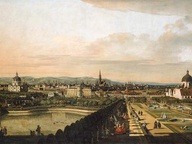Inventing the Truth. On Fiction and Reality

Carmen Dobre-Hametner, Consuming History, 2015, digital photograph, series of 12, 30.2 x 55.9 cm each, ultrachrome print on lightbox, edition of 5 + 2 ap. Courtesy: the artist
From 09 Maggio 2015 to 22 Novembre 2015
Venice
Place: Biennale Palazzo Correr / Pav. Romania
Address: Cannaregio 2214, Campo Santa Fosca
Responsibles: Diana Marincu
Organizers:
- Romanian Cultural Institute
- Monica Morariu
- Alexandru Damian
The blurry line between fiction and reality defines the current cultural context which bases its understanding of the world on objectifying imagination, actualizing possibilities and reworking the image of history and its meaning. This almost organic extension of fiction allows for articulating certain creative hypotheses on the past and the present, activating a new relation between what is and what could be in reality. The field where truth and fiction intersect has become today more interesting than the territories which it once separated, leaving room for fiction to manifest outside its “legitimate” fields of action – literature or art – and for reality to acquire new meanings.
The exhibition Inventing the Truth locates itself at this crossroad and takes shape through two simultaneous research directions – one which interprets fiction as the “repressed” part of the history’s discourse (as defined by Michel de Certeau), and another focusing on the seemingly banal everyday in which quotidian elements are poetically re-contextualized and temporally recomposed with the aid of fiction. The transformation of the past into the solid substance of history is always an excessive action, a political gesture, a subjective intrusion on the part of those who research an archive. Therefore, the works presented here will enrich the analysis of history through the insertion of fiction and personal micro- histories.
However, the present holds an even higher versatility of interpretation and a better dynamics of the narrative construction by means of real time reviews and corrections. Narrating the present actually generates a “disorderly” image of truth (as the perfect reflection of reality) and new intuitions of the future. The vast repertoire of contemporary culture is used by the artists in view of validating multiple truths, plural interpretations and the potential of each narrative direction which is born thereby, thus responding to Okwui Enwezor’s general theme, namely the instrumentation of fiction for the purpose of grasping the current state of things. The exhibited works – object, photography, video or performance – bring to the forefront both the process of interpretation as well the production of such narratives. The visual construction of each project undertakes the conventions of fiction, making visible the traces of the author and the subtle sutures that bind together authenticity and invention. The impossibility of identifying the limits of reality determine the viewer to vacillate between how convincing and how jarring the staging is.
Consuming History, the photographic project of Carmen Dobre-Hametner (b. 1978), starts from the premise that all social practices create realities and history is one of the elements subjected to this process. Looking at history as radical alterity, this project focuses on the extreme experience of discovering history as real life, through the perfect reenactment. The Soviet Bunker in Vilnius, a theme park opened in 2008 on the place of a soviet secret service outpost, takes over the makeup of the former political regime and is available for all tourists interested in living through the ordeal of interrogation, arrest and aggression by actors who play the roles of executioners or secret service officers. Carmen Dobre-Hametner will photograph the individuals who have opted for the tour, in the hypostasis of victims of the reenacted communist internment camp. The mix between historical props (the costumes of the actors and the scenery suggesting the settings of the gulag) and contemporary details (in the clothing, accessories and attitudes of the tourists) will be integrated to a cinematic aesthetic which refers to both fictionalizing history through the re-staging thereof, and to undertaking fiction as a real experience. The “obscene” reality which brings the spectator in dangerous proximity to the stage of action determines certain acute sensitivities to the excess of real or hyperreality (defined by Jean Baudrillard as simulacrum, paroxysm and parody, abuse of information and image). Consuming History inquires on the need of individuals to get a taste of hyperreality by means of extreme experiences and to make an attempt for achieving their presence in the past (according to Fridric Jameson’s concept of “nostalgia for the present”).
Ștefan Sava (b. 1982) proposes a video essay on the potential and limits of interpreting a personal archive containing photographs from interbellum and postwar Germany. Having selected 145 frames from the 850 acquired at a flee market in Berlin, Ștefan Sava questions the visual representation of a traumatic past. Each image is submitted to an archeology of the image based on the dialectics between what is rendered visible and what is left out from the visual field. The video The Falling of the Arches reviews various theoretical approaches to looking as well as the interpretation of the images according to the methodology indicated by Georges Didi-Huberman – privileging singularity in the detriment of a unifying, collective vision. Thus the discontinuance, as a strategy of furthering knowledge, and the flexibility of free associations between images through comparisons, similarities and differences, are put to work. 
Larisa Sitar (b. 1984) presents the continuation of her project centered on constructing false dioramas that touch on the relation between history and ideology. History is always violence while ruin best represents dislocation, rupture, and death, therefore phenomena which mark the transition from one political regime to the other. Covering hundreds of years of human history and progress, the collages put together by Larisa Sitar are equally misleading and sincere, manipulating and honest with the viewers.
Michele Bressan’s (b. 1980) work Present appropriates an object, namely the book entitled Mystical Births by Mircea Eliade, which bears the potential of completely leaving the spatial and temporal reality. This is a present from the artist’s mother, displaying the handwritten text dated on April 31, 2014. As April has only 30 days, this date does not exist. Through misplacing this event in time, the gesture becomes abstract and suspended outside chronological conventions. Personal history replaces the objective one and single-handedly sustains the intensity of a gesture for which there is no tangible truth. What remains is only the story of an “improved” reality, extended by one day. This is a retrospective influence on a life which has gained one more day. The work Single Use puts forth apparently banal objects in a state of exception, by investing them with a new role – of keeping the promise and intention of the product intact and hidden. The containing unprocessed films are in a permanent state of delaying the revelation and of projecting an inaccessible content. 
Lea Rasovszky (b. 1986) composes a story from some fragments of true stories researched by her, personal memories and book excerpts. Fiction becomes here an integral part of the storyteller’s life and is matched with a visual setting that is site-specific to the New Gallery. The audio-video installation starts from the idea that there are certain “psychological realities” and melancholic feeling which influence the relation between mental projections and real perceptions. 
Alex Mirutziu (b. 1981) continues the series Bureaucratic Object which relies on attributing to each word making up a poem the responsibility of determining the spacing of the lyrics, the relation to the typing font, the ratio between written and blank spaces as well as the spontaneous meaning connections that form on the sheet of paper. All the words which make up some of Graham Foust’s poems are cut out and recombined with fragments from W.H. Auden’s poems, thus forcing a dialogue across time and style. These collages are added to the performance entitled The Finnish Method, taking over the idea of “ontological design”, in view of studying, by means of an ensemble of pieces of furniture, the way in which people influence objects and vice versa. 
Sitting on this pervious border between reality and imagination, the exhibition Inventing the Truth recasts the interpretations of history and invents new strategies for rethinking the relationship between truth and fiction.
The exhibition Inventing the Truth locates itself at this crossroad and takes shape through two simultaneous research directions – one which interprets fiction as the “repressed” part of the history’s discourse (as defined by Michel de Certeau), and another focusing on the seemingly banal everyday in which quotidian elements are poetically re-contextualized and temporally recomposed with the aid of fiction. The transformation of the past into the solid substance of history is always an excessive action, a political gesture, a subjective intrusion on the part of those who research an archive. Therefore, the works presented here will enrich the analysis of history through the insertion of fiction and personal micro- histories.
However, the present holds an even higher versatility of interpretation and a better dynamics of the narrative construction by means of real time reviews and corrections. Narrating the present actually generates a “disorderly” image of truth (as the perfect reflection of reality) and new intuitions of the future. The vast repertoire of contemporary culture is used by the artists in view of validating multiple truths, plural interpretations and the potential of each narrative direction which is born thereby, thus responding to Okwui Enwezor’s general theme, namely the instrumentation of fiction for the purpose of grasping the current state of things. The exhibited works – object, photography, video or performance – bring to the forefront both the process of interpretation as well the production of such narratives. The visual construction of each project undertakes the conventions of fiction, making visible the traces of the author and the subtle sutures that bind together authenticity and invention. The impossibility of identifying the limits of reality determine the viewer to vacillate between how convincing and how jarring the staging is.
Consuming History, the photographic project of Carmen Dobre-Hametner (b. 1978), starts from the premise that all social practices create realities and history is one of the elements subjected to this process. Looking at history as radical alterity, this project focuses on the extreme experience of discovering history as real life, through the perfect reenactment. The Soviet Bunker in Vilnius, a theme park opened in 2008 on the place of a soviet secret service outpost, takes over the makeup of the former political regime and is available for all tourists interested in living through the ordeal of interrogation, arrest and aggression by actors who play the roles of executioners or secret service officers. Carmen Dobre-Hametner will photograph the individuals who have opted for the tour, in the hypostasis of victims of the reenacted communist internment camp. The mix between historical props (the costumes of the actors and the scenery suggesting the settings of the gulag) and contemporary details (in the clothing, accessories and attitudes of the tourists) will be integrated to a cinematic aesthetic which refers to both fictionalizing history through the re-staging thereof, and to undertaking fiction as a real experience. The “obscene” reality which brings the spectator in dangerous proximity to the stage of action determines certain acute sensitivities to the excess of real or hyperreality (defined by Jean Baudrillard as simulacrum, paroxysm and parody, abuse of information and image). Consuming History inquires on the need of individuals to get a taste of hyperreality by means of extreme experiences and to make an attempt for achieving their presence in the past (according to Fridric Jameson’s concept of “nostalgia for the present”).
Ștefan Sava (b. 1982) proposes a video essay on the potential and limits of interpreting a personal archive containing photographs from interbellum and postwar Germany. Having selected 145 frames from the 850 acquired at a flee market in Berlin, Ștefan Sava questions the visual representation of a traumatic past. Each image is submitted to an archeology of the image based on the dialectics between what is rendered visible and what is left out from the visual field. The video The Falling of the Arches reviews various theoretical approaches to looking as well as the interpretation of the images according to the methodology indicated by Georges Didi-Huberman – privileging singularity in the detriment of a unifying, collective vision. Thus the discontinuance, as a strategy of furthering knowledge, and the flexibility of free associations between images through comparisons, similarities and differences, are put to work. 
Larisa Sitar (b. 1984) presents the continuation of her project centered on constructing false dioramas that touch on the relation between history and ideology. History is always violence while ruin best represents dislocation, rupture, and death, therefore phenomena which mark the transition from one political regime to the other. Covering hundreds of years of human history and progress, the collages put together by Larisa Sitar are equally misleading and sincere, manipulating and honest with the viewers.
Michele Bressan’s (b. 1980) work Present appropriates an object, namely the book entitled Mystical Births by Mircea Eliade, which bears the potential of completely leaving the spatial and temporal reality. This is a present from the artist’s mother, displaying the handwritten text dated on April 31, 2014. As April has only 30 days, this date does not exist. Through misplacing this event in time, the gesture becomes abstract and suspended outside chronological conventions. Personal history replaces the objective one and single-handedly sustains the intensity of a gesture for which there is no tangible truth. What remains is only the story of an “improved” reality, extended by one day. This is a retrospective influence on a life which has gained one more day. The work Single Use puts forth apparently banal objects in a state of exception, by investing them with a new role – of keeping the promise and intention of the product intact and hidden. The containing unprocessed films are in a permanent state of delaying the revelation and of projecting an inaccessible content. 
Lea Rasovszky (b. 1986) composes a story from some fragments of true stories researched by her, personal memories and book excerpts. Fiction becomes here an integral part of the storyteller’s life and is matched with a visual setting that is site-specific to the New Gallery. The audio-video installation starts from the idea that there are certain “psychological realities” and melancholic feeling which influence the relation between mental projections and real perceptions. 
Alex Mirutziu (b. 1981) continues the series Bureaucratic Object which relies on attributing to each word making up a poem the responsibility of determining the spacing of the lyrics, the relation to the typing font, the ratio between written and blank spaces as well as the spontaneous meaning connections that form on the sheet of paper. All the words which make up some of Graham Foust’s poems are cut out and recombined with fragments from W.H. Auden’s poems, thus forcing a dialogue across time and style. These collages are added to the performance entitled The Finnish Method, taking over the idea of “ontological design”, in view of studying, by means of an ensemble of pieces of furniture, the way in which people influence objects and vice versa. 
Sitting on this pervious border between reality and imagination, the exhibition Inventing the Truth recasts the interpretations of history and invents new strategies for rethinking the relationship between truth and fiction.
SCARICA IL COMUNICATO IN PDF
56th international art exhibition la biennale di venezia ·
inventing the truth on fiction and reality ·
michele bressan ·
carmen dobre hametner ·
alex mirutziu ·
lea rasovszky ·
stefan sava ·
larisa sitar ·
michele bressan carmen dobre hametner alex mirutziu lea rasovszky stefan sava larisa sitar
COMMENTI

-
 Dal 31 gennaio 2024 al 04 maggio 2025
Fermo | Palazzo dei Priori
Dal 31 gennaio 2024 al 04 maggio 2025
Fermo | Palazzo dei Priori
-
 Dal 20 dicembre 2024 al 04 maggio 2025
Fermo | Palazzo dei Priori
Dal 20 dicembre 2024 al 04 maggio 2025
Fermo | Palazzo dei Priori
-
 Dal 20 dicembre 2024 al 04 maggio 2024
Gorizia | Palazzo Attems Petzenstein
Dal 20 dicembre 2024 al 04 maggio 2024
Gorizia | Palazzo Attems Petzenstein
-
 Dal 18 dicembre 2024 al 18 dicembre 2024
Venezia | Museo Correr
Dal 18 dicembre 2024 al 18 dicembre 2024
Venezia | Museo Correr
-
 Dal 14 dicembre 2024 al 02 marzo 2025
Palermo | Palazzo Abatellis
Dal 14 dicembre 2024 al 02 marzo 2025
Palermo | Palazzo Abatellis
-
 Dal 12 dicembre 2024 al 23 febbraio 2025
Roma | Palazzo Altemps
Dal 12 dicembre 2024 al 23 febbraio 2025
Roma | Palazzo Altemps


